Learning to sail is an exhilarating and rewarding experience, but it’s crucial to choose the right sailboat to ensure a safe and enjoyable journey. While at Rubicon 3 we charge around the world on some big, serious sailing adventures and we’ll teach you loads, sailing small boats also provides a wonderful way to sail, develop your practical skills and have some fun on the water. We often get asked which boats we’d recommend, so we’ve summarized our thoughts for you here.
For beginners, selecting a small, stable, and easy-to-handle sailboat will make the learning process so much smoother and more enjoyable. Factors like boat size, stability, maneuverability, and cost are key and you’ll want to consider them carefully to find the perfect match for your skill level and sailing goals.
Importantly, small sailboats offer a very gentle introduction to the world of sailing, allowing you to develop essential skills and gain confidence on the water. These boats are typically much more forgiving and responsive than bigger boats, making them ideal for practising basic techniques like tacking, jibing, and handling the sails. Additionally, their compact size and lighter weight make them easier to launch, transport, and maintain, reducing the overall complexity for beginners.
Types of Small Sailboats for Beginners
There are two main categories of small sailboats suitable for learning: dinghies and keelboats/daysailors. Each has its own advantages (and challenges) for beginners.
Dinghies
These are small, lightweight boats with a centreboard or daggerboard instead of a fixed keel ands often just a single sail. They are highly responsive and can be easily righted if capsized, making them an excellent choice for learning those basic sailing skills.
Keelboats/daysailors
These are slightly larger than dinghies and feature a fixed keel, which provides more stability and better tracking in the water. They are more forgiving and easier to control than dinghies, making them suitable for those who want a more comfortable learning experience.
Learning on Dinghies
One of the main characteristics of a sailing dinghy is its stability and forgiving nature. Many sailing dinghies, such as the Sunfish, Laser, and Zuma, have a wide beam and a low center of gravity, making them less prone to capsizing. This stability is crucial for beginners who are still developing their sailing skills and confidence on the water.
Popular dinghy models for learning include:
Sunfish
This 14-foot racing dinghy is a classic choice for sailing schools and recreational sailing. It’s lightweight, has a super easy lateen rig, and is incredibly stable, making it an excellent boat for beginners to learn the basics of sailing.
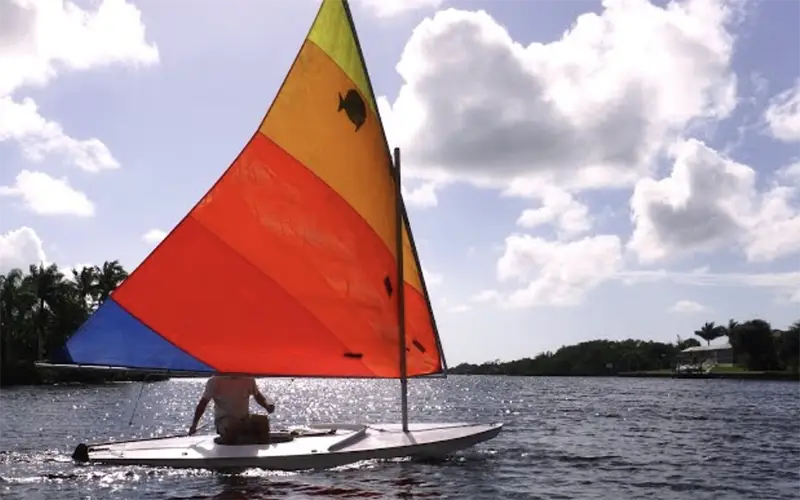
Laser
The Laser is a 13.5-foot dinghy that has been popular for decades. While it’s not maybe best suited as a beginner sailboat due to its responsive handling, the Laser is a great option for those who want to progress quickly and develop advanced sailing skills.
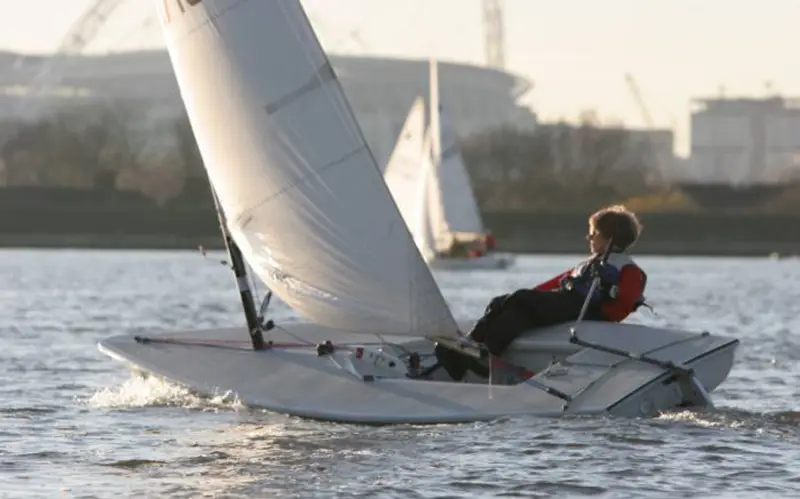
Zuma
The Zuma is a 16-foot dinghy designed specifically for sailing instruction and recreational sailing. Its wide beam and stable hull make it a forgiving boat for beginners, while its performance capabilities allow for further skill development.
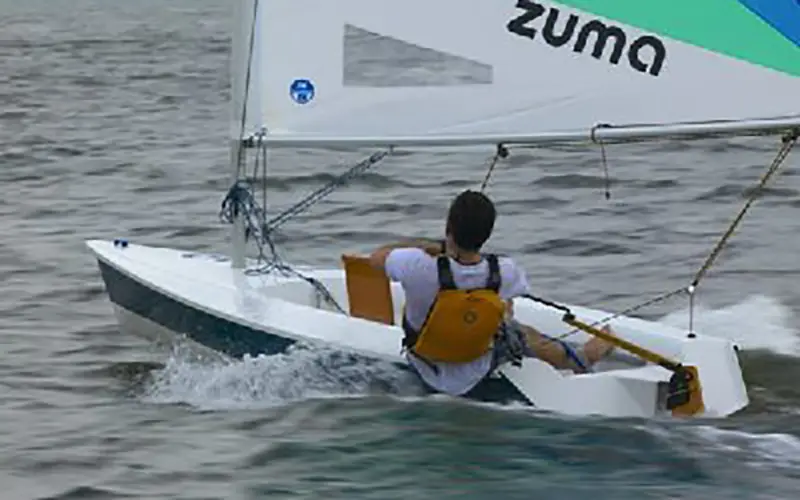
Pros of dinghy sailboats for beginners:
- Affordability: Dinghies are generally less expensive than larger sailboats, making them accessible for those on a budget.
- Easy to rig and launch: Most dinghies can be rigged and launched by one or two people, eliminating the need for a large crew.
- Stability and forgiving nature: The wide beam and low center of gravity of dinghies make them less prone to capsizing, instilling confidence in beginners.
Cons of dinghy sailboats for beginners:
- Limited space and amenities: Dinghies typically have minimal storage space and lack any amenities like cabins or toilets.
- Exposure to the elements: With no cabin or shelter, sailors in dinghies are fully exposed to the wind, rain, and sun.
- Skill progression limitations: While dinghies are excellent for learning the basics, sailors may eventually outgrow their capabilities and need to transition to larger boats.
Overall, dinghy sailboats provide an ideal platform for beginners to learn the fundamentals of sailing in a stable and forgiving environment. Their affordability and ease of handling make them a popular choice for sailing schools and recreational sailors alike.
Learning on Keelboats/daysailors
Keelboats are a popular choice for learning to sail, offering more stability and space compared to smaller dinghies. These sailboats feature a weighted keel that extends below the hull, providing improved tracking and resistance to heeling over in stronger winds.
Characteristics of Keelboats:
- Length typically ranges from 20 to 35 feet
- Displacement hulls with a deep, weighted keel
- Cabin for shelter and storage
- Multiple sails, including mainsail and jib
- Auxiliary engine for motoring when needed
Popular Models for Beginners:
Catalina 22
A compact and affordable keelboat, known for its forgiving nature and easy handling
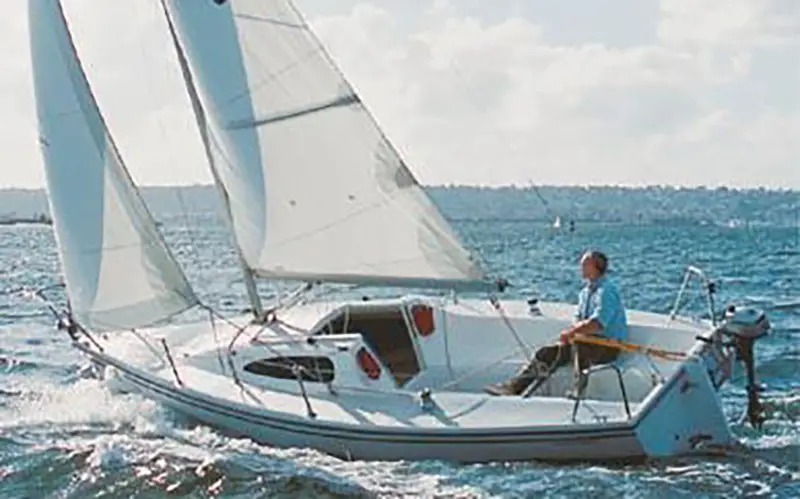
Pearson 26
A sturdy and well-balanced boat, suitable for both daysailing and overnight trips.
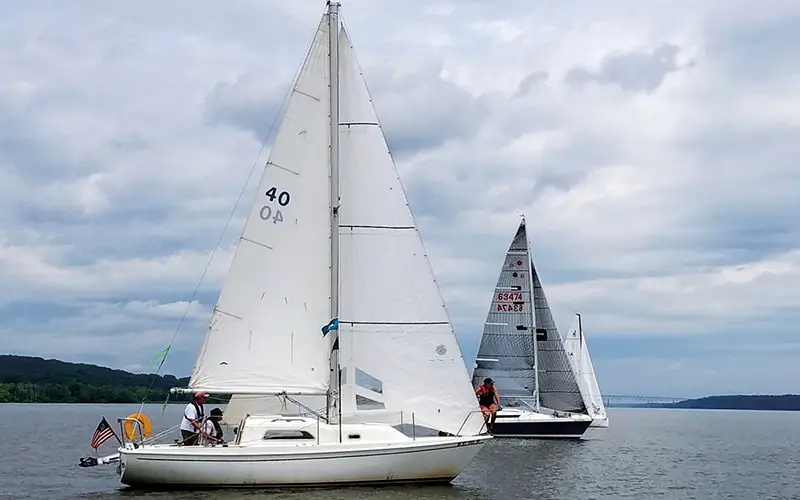
Hunter 27
A spacious and stable pocket cruiser, designed with a focus on comfort and ease of use.
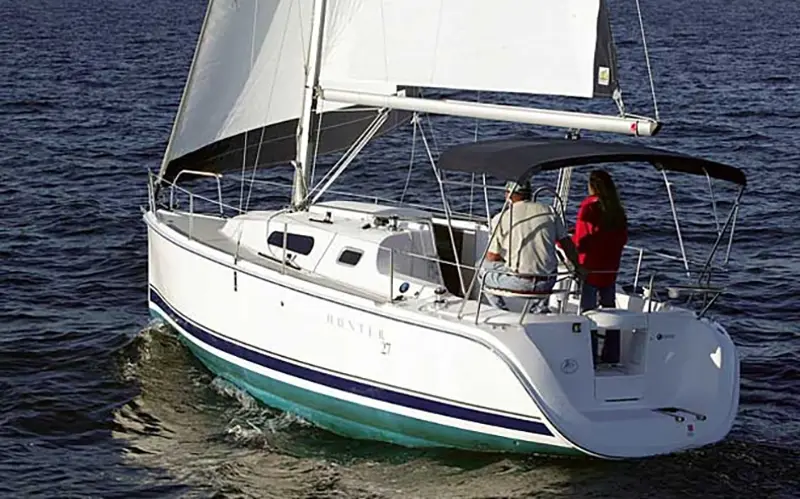
West Wight Potter 19
A compact, trailerable sailboat renowned for its stability and versatility. The boat’s shallow draft and retractable keel allow for easy launching, beaching, and navigating.
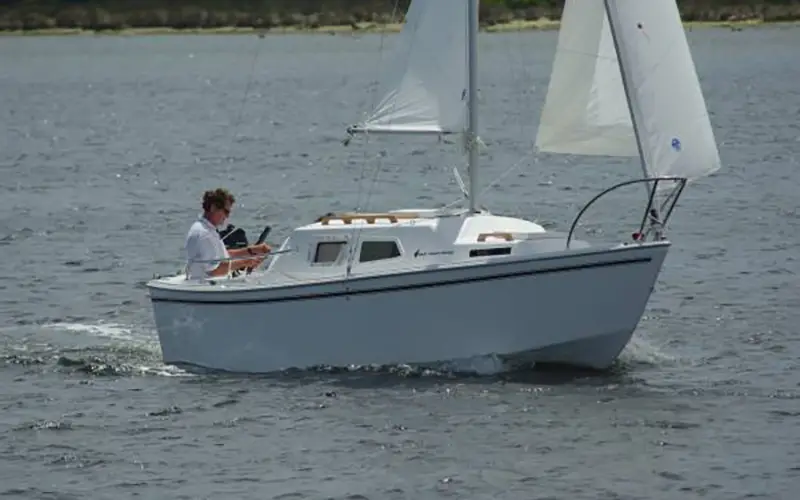
Pros for Beginners:
- Increased stability and safety compared to smaller boats
- Cabin provides shelter from weather and overnight accommodation
- More space for friends and family to join
- Auxiliary engine for added confidence and maneuverability
Cons for Beginners:
- Generally more expensive than dinghies
- Larger size can be more challenging to dock and maneuver
- Requires more crew for efficient sailing
- Maintenance and storage costs can be higher
Keelboats offer a great platform for learning to sail, providing a stable and comfortable environment while still allowing for the development of essential sailing skills. With their versatility and accommodation, they can grow with you as your sailing experience expands.
Factors to consider: stability
Stability is a key consideration when choosing a small sailboat for beginners. A stable boat provides a sense of security and confidence, allowing you to focus on mastering sailing techniques without the constant worry of capsizing.
One of the primary factors affecting a sailboat’s stability is its keel design. A longer, deeper keel provides more resistance to heeling (leaning to one side), making the boat more stable in stronger winds and choppy waters. Keelboats, as the name suggests, have a weighted keel that lowers the boat’s center of gravity, increasing its righting moment and resistance to capsizing.
Ballast, or the weight added to the bottom of the hull, also contributes significantly to a boat’s stability. Boats with more ballast are less prone to excessive heeling, which can be particularly reassuring for novice sailors.
Hull design plays a role as well. Wider, beamier hulls with a greater waterline length tend to be more stable than narrow, lightweight hulls. However, this increased stability often comes at the cost of reduced speed and maneuverability.
For beginners, prioritizing stability over speed is a must, as it allows you to develop your skills and confidence in a forgiving environment. As your sailing abilities improve, you can gradually transition to more performance-oriented boats if desired.
Factors to consider: Ease of Handling and Maneuverability
When learning to sail, another crucial factors to consider is the ease of handling and maneuverability of the sailboat. As a beginner, you’ll want a boat that is responsive, forgiving, and easy to control, allowing you to focus on mastering the fundamentals of sailing without being overwhelmed by the vessel’s complexity.
The sail plan and rigging of a sailboat play a significant role in its handling characteristics. Smaller boats with simpler rigs, such as a single mast and a mainsail or a mainsail and jib combination, are generally easier to manage than larger boats with more complex sail plans. The size of the sails also affects the ease of handling, with smaller sails being more manageable for beginners.
Factors to consider: Affordability and Cost
One of the significant advantages of small sailboats is their affordability, making them an excellent choice for those looking to learn and enjoy sailing without breaking the bank. Their cost can vary widely depending on the type, size, age, and condition.
For entry-level dinghies, such as the Sunfish or Laser, you can expect to pay anywhere from $1,000 to $5,000 for a used boat in good condition. New dinghy sailboats can range from $3,000 to $10,000, depending on the model and features. These small, lightweight boats are relatively inexpensive to maintain and store, making them an economical option for beginners.
Keelboats, such as the Catalina 22 or Hunter 23, can cost between $5,000 and $20,000 for a used boat in decent condition. New keelboats in this size range can cost anywhere from $20,000 to $50,000 or more, depending on the brand, features, and level of customization. While more expensive than dinghies, keelboats offer more stability and living space, making them a popular choice for those who plan to sail on larger bodies of water.
In addition to the initial purchase cost, it’s also essential to consider the ongoing costs of ownership and maintenance. These can include insurance, slip fees or dry storage, repairs, and upgrades. Generally, smaller sailboats have lower maintenance costs compared to larger vessels, but it’s still important to factor in these expenses when budgeting for your new sailing adventure.
Buying a used sailboat can be a great way to save money, but be absolutley sure to have the boat inspected by a professional surveyor to ensure it’s in good condition and safe to sail.
Sailing Schools and Rental Options
Signing up to a sailing course from a sailing school is also highly recommended for beginners looking to learn the ropes. Sailing schools offer structured courses taught by experienced instructors, providing a safe and controlled environment to learn essential skills.
Sailing schools and sailing clubs are also an opportunity to try out different types of small sailboats before committing to a purchase. Many schools offer rental options, allowing students to experience various boat designs and sizes. This hands-on approach can help beginners determine which type of sailboat best suits their needs and preferences.
Overall, sailing schools and rental options are valuable resources for beginners looking to learn to sail in a controlled and supportive environment.
A note on safety equipment
When you’re learning to sail, having the right safety equipment on board is crucial. Even on small sailboats, you should try to be prepared for any potential situation that may arise.
Life Jackets: Life jackets, also known as personal flotation devices (PFDs), are perhaps the most important safety equipment on any boat. They should be worn at all times while on the water, regardless of the sailor’s swimming ability or the weather conditions. Look for life jackets that are Coast Guard-approved, properly fitted, in good condition and that have a whistle
Flares: Flares are essential for signaling distress and attracting attention in an emergency situation. There are different types of flares, including hand-held flares, parachute flares, and smoke flares. If you’re heading a little further afield, this is a wise addition. Make sure to store them properly and check their expiration dates regularly.
Anchor and Anchor Line: An anchor and anchor line will be key. The anchor should be appropriate for the size and weight of your sailboat, and the anchor line should be long enough to accommodate different depths and conditions. A basic rue of thumb is 4-5 times the maximu depth you expect to anchor in.
First Aid Kit: Bring a well-stocked first aid kit, with some bandages, antiseptic wipes, gauze pads, and any necessary medications.
Radio or Communication Device: A radio or other communication device, will be invaluable in case of a situation where you need help.
Bucket or Bailer: A bucket or bailer is useful for bailing out water that may accumulate in the bilge or cockpit due to waves or leaks.
Toolbox and Spare Parts: Carrying a basic toolbox and spare parts, such as shackles, lines, and sail repair tape, can help you address minor issues that may arise during your sailing adventure.
Final thoughts on choosing the right sailboat
When choosing a sailboat carefully consider your specific needs, preferences, and goals as a beginner sailor. These are the key factors to keep in mind when looking to buy your own boat:
Skill Level: Assess your current sailing experience and choose a boat that aligns with your skill level. If you’re an absolute beginner, opt for a stable and forgiving boat that’s easy to handle.
Sailing Conditions: Consider the water conditions where you’ll be sailing. If you’ll be sailing on lakes or protected bays, a dinghy might be suitable. For coastal waters or open seas, a keelboat with more stability and safety features may be preferable.
Crew Size: Determine whether you’ll be sailing solo or with a crew. Some small sailboats are designed for single-handed sailing, while others accommodate two or more people.
Purpose: Decide whether you want a sailboat primarily for learning and recreational sailing or if you plan to race or participate in regattas in the future. Certain boats are better suited for specific purposes and you can always progress to other boats later.
Budget: Establish a realistic budget for purchasing or renting a sailboat. Consider not only the initial cost but also ongoing maintenance, storage, and transportation expenses.
Portability: If you plan to transport your sailboat frequently, look for a lightweight and easily trailerable option. A big boat will be less portable.
Storage: Determine where you’ll store your sailboat when not in use. Some boats require specialized storage facilities, while others can be stored on trailers or in your backyard. Obviously, a small boat will always be easier to store.
Growth Potential: While you’re learning, it’s wise to choose a sailboat that allows you to grow your skills over time without outgrowing the boat too quickly.
Remember, the “perfect” sailboat doesn’t exist – it’s about finding the one that best suits your needs, abilities, and preferences as a beginner sailor. Don’t hesitate to seek advice from experienced sailors or sailing instructors to help you make an informed decision.
Conclusion
So, cross the Rubicon! Embrace the adventure, take the leap, and let the wind be your guide. The open waters await, and with the right small sailboat, you’ll be ready to embark on a lifelong passion that will bring you countless moments of joy, challenge, and personal growth.